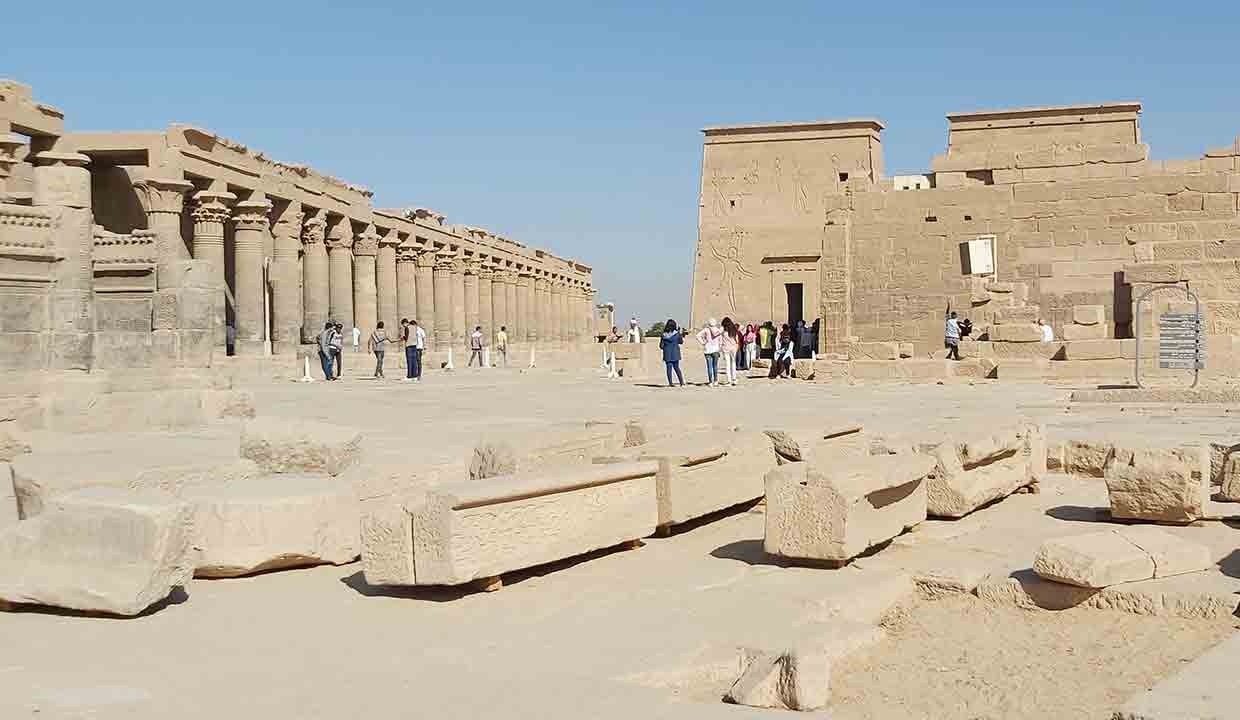3 Amazing information about Architectural Marvel of Philae.
Philae Temple Complex: A dance of ancient deities and modern engineering, set on the serene Nile.
In the intricate tapestry of Egypt’s historical landscape, the Philae Temple Complex is a gem that uniquely straddles both ancient religious devotion and contemporary engineering prowess. Residing on an island amidst the calm waters of the Aswan Low Dam’s reservoir, this temple complex offers a compelling tale of preservation, devotion, and resilience.
Philae, a tiny island just 450 metres long and less than 150 metres wide, has long captivated the imagination of Egyptian visitors. It was famous for its beauty and was dubbed the “Pearl of Egypt”. Plants and palm trees sprouted from the fertile deposits that had accumulated in the crevices of the granite bedrock. Beautiful Graeco-Roman temples and colonnades, kiosks and sanctuaries rose proudly against the skyline. There was an air of mystery. Not furtive in the sense of violating secrets, but rather veiled mystification.
Philae Temple This temple dedicated to the goddess Isis, which was flooded by the Nile’s waters, is known as the Temple of Love. It was divided and reassembled in a new location on the island of Egilika, about 500 meters from its original location on Philae. Its structures include the Temple of Hathor, and visitors can enjoy the nightly sound and light show, which is presented in several languages.
It is located on a small island and is only accessible by boat because it is surrounded by water on all sides.
Historical Background of Philae Temple Complex
Philae, in its original glory, was situated on an island in the Nile River. This island was considered sacred to the goddess Isis and served as a major religious center for worship and pilgrimage. Over centuries, various rulers – from the Pharaohs to the Ptolemaic kings and the Romans – contributed to the expansion of this temple complex, with each leaving a unique imprint and a testimony to their devotion.
Architectural Marvel and Significance of Philae Temple Complex
- Temple of Isis: This is the main temple in the complex, dedicated to the goddess Isis. A stunning example of Greco-Roman architecture, the temple was among the last outposts for ancient Egyptian religion, persisting even into the Christian era.
- Trajan’s Kiosk: A hypaethral structure, this was likely intended as a river entrance to the temple complex. Its 14 columns once supported a wooden roof, and today, its silhouette against the Egyptian sky is hauntingly beautiful.
- Chapel of Horus: A dedication to the falcon-headed god, this small and intricately designed chapel showcases the blending of religious beliefs and architectural styles over time.
The Challenge of Modern Times and UNESCO’s Rescue Operation
The construction of the Aswan Low Dam in the early 20th century threatened the very existence of Philae. As the Nile’s waters rose due to the dam, the Philae Temple Complex began to submerge. And while this submersion was periodic initially, the building of the Aswan High Dam in the 1960s threatened to submerge the temple permanently.
Recognizing its historical and cultural significance, UNESCO initiated the ‘Save the Monuments’ campaign. The monumental rescue operation that followed is a testament to human ingenuity:
- The temples were meticulously dismantled.
- An artificial island, called Agilkia and located nearby, was chosen due to its similarity to Philae’s original island.
- The island was then molded to resemble the original Philae, ensuring that the temples’ original directions were maintained.
- Finally, over 40,000 blocks of stone were moved and reassembled on Agilkia, ensuring that Philae’s glory was restored and preserved for future generations.
Conclusion
Today, when visitors sail to the Philae Temple Complex, they witness not just the grandeur of ancient Egyptian civilization but also an embodiment of international cooperation and dedication to preserving humanity’s shared heritage. The harmony of Philae’s sanctums, courtyards, and colonnades, set against the tranquil backdrop of the Nile, makes it a dream for history enthusiasts, architects, and spiritual seekers alike.
Explore Egypt Tours Tripadvisor



Comment (0)